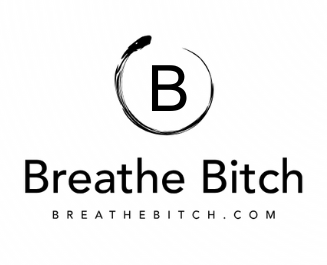Breathe Bitch-
Inner Peace is the
New Wealthy
Once you obtain it, you will be unstoppable.
Become a
BREATHE BITCH BAD ASS
Join the Mindful Movement
You’re not here to stay small — you’re here to release the highest version of yourself.
Through Breathwork, Meditation, Mindful Motivation, Wellness Coaching, personal training and community. This is where breathwork meets boldness. Where healing stops feeling “soft” and starts feeling powerful. Be your best physically mentally and emotionally.
Inside this space, you’ll shed old stories, break free from stress, and step fully into the unstoppable you
Download our 2026–2027 Breathwork Cheat Sheet (PDF). Learn 8 evidence‑based breathing techniques for calm, energy, focus, and better sleep.
Breathwork cheat sheet pdf, Breathwork cheat sheet free, breathwork training, breathwork facilitator training, pause breathwork, breathwork facilitator training in-person
Breathwork exercises Cheat Sheet, Breathwork tips Cheat Sheet , Breathwork practices Cheat Sheet, Breathwork benefits Cheat Sheet., Breathing exercises Cheat Sheet, Breath control techniques Cheat Sheet, Conscious breathing methods Cheat Sheet, Deep breathing techniques
Cheat Sheet, Mindful breathing exercises Cheat Sheet, Breathwork guide Cheat Sheet, Breathwork resources Cheat Sheet Cheat Sheet, Breathwork for beginners Cheat Sheet, Breathwork meditation Cheat Sheet, Breathwork techniques for stress relief Cheat Sheet, Breathing techniques for relaxation Cheat Sheet, Breathwork techniques for anxiety, Breathwork techniques for mindfulness, Breathwork techniques for energy, Breathwork techniques for focus Cheat Sheet.
Breathwork Cheat sheet
Breathwork breathing techniquesCheat Sheet 2024 - 2025 PDF
The 8 Essential Breathing Techniques
Technique 1 — Box Breathing (Square Breath)
How: Inhale 4s → Hold 4s → Exhale 4s → Hold 4s. Repeat 1–5 minutes.
Best for: Stress, composure, focus (pre‑meeting/onsite).
Pro tip: Trace a mental square while counting.
Technique 2 — 4‑7‑8 Breath
How: Inhale 4s → Hold 7s → Exhale 8s (slow). Repeat 4–8 cycles.
Best for: Sleep, emotional down‑regulation.
Pro tip: Make the exhale silent and longer than the inhale.
Technique 3 — Belly Breathing (Diaphragmatic)
How: Inhale 5s, expanding the belly → Exhale 5s, soften the ribs.
Best for: Grounding, tension release, all‑day resets.
Pro tip: Place a hand on your belly to feel movement.
Technique 4 — Alternate Nostril (Nadi Shodhana)
How: Close right nostril → Inhale left → Close left → Exhale right → Inhale right → Close right → Exhale left. Repeat 1–3 minutes.
Best for: Balance, mental clarity, pre‑creative work.
Pro tip: Keep breath smooth; don’t force.
Technique 5 — Humming Bee (Bhramari)
How: Inhale deep → Exhale with a steady hum. Feel vibration in face/head.
Best for: Quieting mental chatter, soothing nerves.
Pro tip: Lower jaw slightly; lengthen each hum.
Technique 6 — Breath of Fire (Kapalabhati)
How: Quick, rhythmic exhales through the nose; belly actively pumps. 30–90s.
Best for: Energy, heat, alertness.
Caution: Avoid if pregnant, dizzy, or with uncontrolled blood pressure.
Technique 7 — Resonant/Coherent Breathing
How: 5–6 breaths per minute (e.g., inhale 5s, exhale 5s).
Best for: Heart‑brain coherence, stress recovery.
Pro tip: Use a timer or app to pace at ~5.5 bpm.
Technique 8 — Ocean Breath (Ujjayi)
How: Light throat constriction; inhale/exhale through the nose with soft “ocean” sound.
Best for: Presence, endurance (yoga/long walks).
Pro tip: Sound should be gentle, not raspy.
Here's a breathwork cheat sheet
1. **Diaphragmatic Breathing**:
- Lie down or sit comfortably with your back straight.
- Place one hand on your chest and the other on your abdomen.
- Inhale deeply through your nose, allowing your abdomen to rise while keeping your chest still.
- Exhale slowly through your mouth, feeling your abdomen fall.
- Repeat for several breaths, focusing on the rhythm and depth of your breath.
2. **4-7-8 Technique**:
- Inhale quietly through your nose for a count of 4.
- Hold your breath for a count of 7.
- Exhale forcefully through your mouth, making a "whoosh" sound, for a count of 8.
- Repeat the cycle for a few rounds, ensuring a relaxed pace.
3. **Alternate Nostril Breathing**:
- Sit comfortably with your back straight.
- Close your right nostril with your right thumb and inhale through your left nostril.
- Close your left nostril with your ring finger, release the right nostril, and exhale through the right.
- Inhale through the right nostril, then close it, release the left nostril, and exhale through the left.
- Repeat for several rounds, alternating nostrils.
4. **Box Breathing**:
- Inhale slowly and deeply through your nose for a count of 4.
- Hold your breath for a count of 4.
- Exhale slowly and completely through your mouth for a count of 4.
- Hold your breath for a count of 4.
- Repeat the cycle for several rounds, maintaining a steady rhythm.
5. **Breath Awareness Meditation**:
- Sit comfortably and close your eyes.
- Focus your attention on your breath, noticing the sensation of air entering and leaving your nostrils.
- Observe the rise and fall of your abdomen with each inhale and exhale.
- When your mind wanders, gently bring your focus back to your breath without judgment.
- Practice for a few minutes to start and gradually increase the duration over time.
6. **Deep Belly Breathing**:
- Lie down comfortably with your knees bent.
- Place one hand on your chest and the other on your abdomen.
- Inhale deeply through your nose, allowing your abdomen to rise and your chest to remain still.
- Exhale slowly through your mouth, feeling your abdomen fall.
- Focus on the sensation of your breath filling your belly and releasing tension.
Remember to encourage clients to practice regularly and to listen to their bodies. Each breathwork technique may have different effects, so it's essential to find what works best for individual needs. Additionally, always emphasize the importance of safety and consulting with a healthcare professional if there are any concerns.w PBreathwork breathing techniquesCheat Sheet 2024 - 2025 PDFaBreathwork breathing techniquesCheat Sheet 2024 - 2025 PDFragraph
**Breathwork Cheat Sheet**
Breathwork involves conscious control and manipulation of breathing patterns to promote relaxation, energy regulation, and overall well-being. Here's a concise guide to different breathwork techniques:
1. **Diaphragmatic Breathing (Deep Belly Breathing)**:
- Sit or lie down in a comfortable position.
- Place one hand on your chest and the other on your abdomen.
- Inhale deeply through your nose, allowing your abdomen to rise while keeping your chest relatively still.
- Exhale fully through your mouth or nose, feeling your abdomen fall.
- Repeat for several cycles, focusing on the sensation of your breath moving in and out.
2. **4-7-8 Technique**:
- Inhale deeply through your nose for a count of 4.
- Hold your breath for a count of 7.
- Exhale slowly through your mouth for a count of 8.
- Repeat for a few rounds, gradually increasing the count if comfortable.
3. **Box Breathing**:
- Inhale deeply through your nose for a count of 4.
- Hold your breath for a count of 4.
- Exhale slowly through your nose for a count of 4.
- Hold your breath for a count of 4 before beginning the next cycle.
- Repeat for several rounds, maintaining a steady rhythm.
4. **Alternate Nostril Breathing (Nadi Shodhana)**:
- Sit comfortably with your spine straight.
- Use your right thumb to close your right nostril and inhale through your left nostril.
- Close your left nostril with your ring finger, and release the thumb from the right nostril.
- Exhale through your right nostril.
- Inhale through your right nostril, close it with your thumb, and exhale through your left nostril.
- This completes one cycle. Repeat for several rounds, focusing on smooth transitions and equal breaths through each nostril.
5. **Sama Vritti (Equal Breathing)**:
- Inhale through your nose for a count of 4.
- Exhale through your nose for a count of 4.
- Maintain equal duration for both inhalation and exhalation.
- Gradually increase the count for longer sessions, ensuring a comfortable rhythm.
6. **Visualization Breathwork**:
- Close your eyes and imagine a calming scene or sensation.
- Sync your breath with the imagery—inhaling positivity and exhaling negativity.
- Focus on deepening relaxation with each breath cycle, letting go of tension and stress.
7. **Breath of Fire (Kapalabhati)**:
- Sit comfortably with an upright spine.
- Inhale deeply through your nose.
- Exhale forcefully through your nose by contracting your abdominal muscles.
- The inhalation is passive; the emphasis is on the forceful exhalation.
- Start with a slow pace and gradually increase speed, aiming for a rhythmic and vigorous breath.
Remember to start slowly and gradually increase the intensity or duration of each technique based on your comfort level. Always listen to your body and adjust as needed. Incorporate breathwork into your daily routine for optimal benefits.
Breathwork cheat SHEET
Breathwork Cheat Sheet
Breathwork refrance guide
Breath work Cheat Sheet
Breathwork Quick Guide
Breathwork, meditation, Mindful Motivation
for a better life







